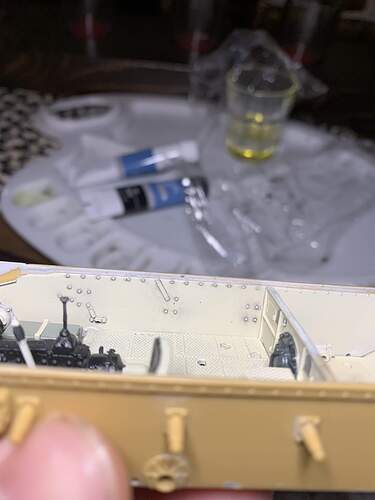When learning the pin-wash technique, it might help to understand how and why the tide marks form.

The area between the raised (or sunken) detail and the ring-like meniscus dries from the inside outward towards the meniscus and inward towards the detail. The inward drying is what creates the desired effect around the detail by concentrating the pigments there.
However, the pigments and the binder (trapped in solution with the carrier / thinner) that are pushed outward towards the meniscus are what form the ring-shaped tide mark after the carrier / thinner has evaporated. It’s the pigments and dried binders that create the visible tide marks - pigments give the tide mark color and the dried binders create the shiny ring (like a dried, clear gloss).
The three common remedies mitigate or eliminate the formation of tide marks by:
Overall gloss coat - Enables the drying action to more readily pull the pigments and binders inward towards the raised of sunken detail, thus leaving less material to form the tide mark. The gloss coat has less surface friction to trap and hold the wash solution. A gloss coat also has the (usually) desirable effect of reducing the amount of pigment particles that can become trapped in the general surface area, so the wash will act less like a filter (tinting the entire finish).
Overall wetting with thinners - Helps to prevent the formation of the meniscus by essentially creating a “center” area between all of the raised or sunken details that can only (mostly) dry towards them without the formation of the meniscus, thereby mitigating the tide marks. The pre-wetting with thinners has the same kind effective action on the wash as the overall gloss coat only using the surface tension of the liquid to spread itself over a larger area rather than doing the same by reducing the surface friction. The easy flow of the wash over the surface and filling the surface with clean thinners also helps to lessen the “filter effect” of the wash by giving the pigments less chance of clinging to the surface between the raised or sunken details.
Using a thinner damp brush to clean up the meniscus materials before they dry - This is pretty self-explanatory. However, it is the only 100% effective method to eliminate (not just mitigate) the formation of tide marks. This should be done as quickly as possible after the pin wash has been applied. If allowed to dry too long, the thinner damp brush may not remove the (now) dried tide marks.
This last note is especially important if using any acrylic paint to make the wash. Acrylic paint binders are generally impervious to re-dissolving with thinners after they have dried.
It’s best practice to only make as many pin-washes as you can clean up before the first of them begins to dry, so work in manageable, small areas, completing one area before doing the next.
If this last method (thinner damp brush removal) is used in conjunction with the other two methods it could mean less overall work is necessary. However, even the first two methods will allow some tide marks to form since the carrier / thinner will always dry fastest where it is the thinnest and has the most exposed area (which is the large areas between the raised or sunken details). As soon as this area starts to dry out, the dried edges of it create other areas where meniscuses can form, and if these meniscuses do form, they will have the potential to dry out leaving tide marks.
I know… This is kind of like telling someone who wants to know the time how to build a watch first. However, knowledge is power.


